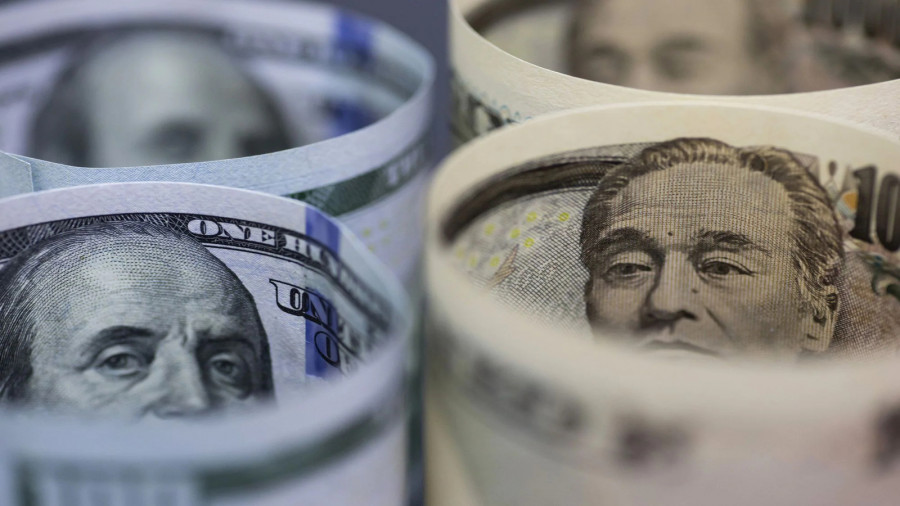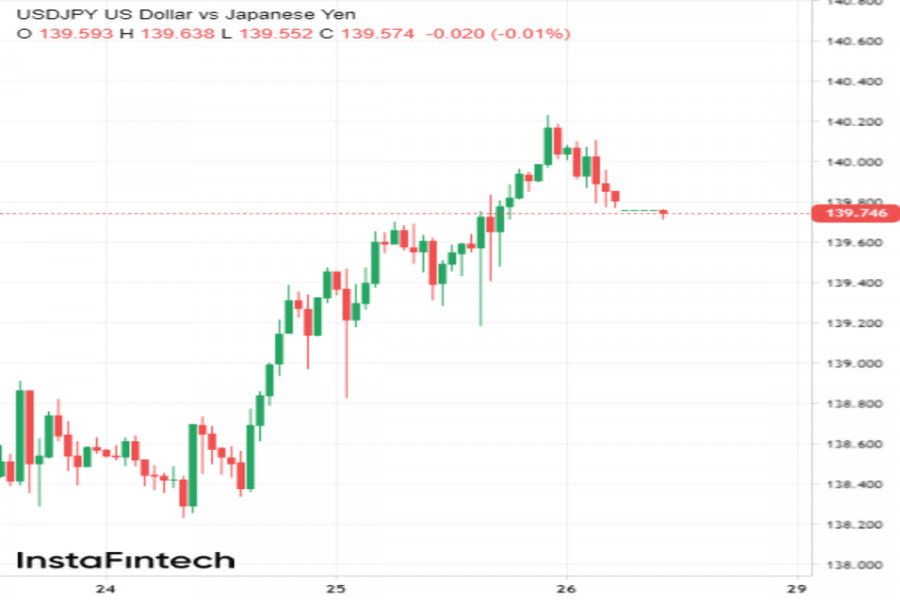USD/JPY has risen strongly for the first time in quite a while. Yesterday, the US dollar advanced by another 0.5%, reaching the highest level since November 2022 at 140.23. However, it was unable to settle at the new high. Let us look at the reasons behind this and whether USD/JPY has a chance to continue its impressive rally.
What drives the dollar higher?
Since Monday, the US dollar has strengthened against a basket of major currencies by more than 1%. This is the third consecutive weekly increase for the greenback. Such a prolonged upward trend for the USD has not been seen since the end of February.
Currently, the key driver of the dollar's growth is panic in the markets, driven by the increasing risk of a global recession.
At present, investors are concerned that US politicians will not reach an agreement to raise the US debt limit by day X - June 1. In such a scenario, the United States will face a technical default on its debt obligations.
The bankruptcy of America poses a threat not only to its economy but also to the entire world. Fear of a global collapse is causing traders to abandon risky assets in favor of safe haven ones. The US dollar is one of the most attractive defensive assets.
On Thursday, demand for the greenback increased again as experts from the international agency Fitch downgraded the US debt rating to AAA with a negative outlook. Their colleagues from Moody's and DBRS Morningstar also warned that they might downgrade the US credit rating.
"While the probability of a technical default is very low, it appears to be materially higher than in past debt ceiling stand-offs due to the current political landscape," Jake Jolly, BNY Mellon Investment Management's head of investment analysis said.
However, yesterday's headlines were full of optimism. The media reported that US President Joe Biden and Speaker of the House Kevin McCarthy were close to reaching a deal to increase the debt ceiling.
Until an official agreement is reached, the markets will remain tense, which benefits the defensive dollar.
On Thursday, the US currency jumped by more than 0.4% against its major competitors and tested 104.31, the highest level since mid-March.
In addition to the risk-off sentiment, USD also received significant support from traders' hawkish expectations regarding further monetary steps by the Federal Reserve (Fed).
Currently, futures markets are pricing a more than 50% probability of the Fed increaing the interest rate by 25 basis points, up from 36% a week ago.
Traders have also revised their predictions regarding possible rate cuts in the US this year. A sharp reduction of the interest rate range is now considered unlikely.
Moreover, an increasing number of market participants are leaning towards the view that the Fed will not ease monetary conditions in the country until the end of the year, as inflation in America remains stable.
What made investors change their minds so abruptly? It can be attributed to the rather aggressive rhetoric of Fed policymakers, as well as positive US macro data that indicate the economy remains strong.
Recent comments from American officials have shown that Federal Reserve members have mixed views on whether to continue raising interest rates or not.
Some prefer to completely pause the current tightening cycle and monitor the lagging impact of previous hikes. Others want to continue raising rates due to sticky inflation.
However, none of them support the idea of cutting the rates this year, which is already a positive factor for the USD.
Positive statistics have also inspired dollar bulls. The data released on Thursday showed that US GDP growth in the first quarter exceeded expectations (1.3% versus 1.1%), and the number of initial jobless claims last week was lower than forecasted (229,000 versus 245,000).
The personal consumption expenditure report also fell short of economists' estimates. In the first quarter, the core PCE index rose not by 4.9% but by 5%.
The combination of optimistic releases and hawkish statements from Federal Reserve policymakers forced market participants to significantly reassess trajectory of interest rates in the US this week. This has positively impacted the yield dynamics of US government bonds across the yield curve.
On Thursday, the yield on 10-year US Treasuries surged to 3.79%. Yield on 5-year and 2-year notes increased to 3.87% and 4.46% respectively. This sharp increase weighed down on the yen strongly, causing the USD/JPY pair to soar by 0.5%. This represents the best daily performance among all dollar assets.
Analyst Marios Hadjikiriakos noted that rising rates in the US were a blessing for the dollar and a curse for the yen, as JPY continued to suffer due to the Bank of Japan's reluctance to tighten its policy.
Recently, investors have significantly lowered their expectations of a possible capitulation by the BOJ. However, the latest data suggests that things may not be so clear-cut.
Is there a chance for the yen?
Some analysts believe that the current fundamental picture hints at an imminent hawkish U-turn by the Japanese regulator.
The economy of Japan is showing signs of confident recovery after the COVID-19 pandemic, while inflation in the country continues to rise steadily.
Today's report on consumer price growth in Tokyo for May served as further evidence that the Bank of Japan may be mistaken about the transitory nature of inflation. Against this backdrop, the dollar retreated from its six-month peak reached in the previous trading session and fell below 140.
Despite the fact that core inflation in the Japanese capital slowed down this month from 3.5% to 3.2%, the CPI, which takes into account expenditures on both fresh produce and fuel, saw the fastest pace of growth in over 40 years, reaching 3.9%.
Data from Tokyo is a leading indicator of nationwide trends. A surge in prices in the capital means that we may soon witness another spike in inflation across the country.
Analyst Takuya Hoshino from the Dai-ichi Life Research Institute noted that there was a high probability that the Bank of Japan might react to sustained inflationary pressure by changing its ultra-loose policy.
Yesterday's statement by Bank of Japan Governor Kazuo Ueda also helped bring back a more hawkish scenario regarding BOJ's future monetary policy.
On Thursday, the head of the institution stated that he would act swiftly if his inflation forecast turned out to be incorrect.
Earlier Kuroda has repeatedly emphasized that price growth should slow down in the coming months as the factors stimulating price growth weaken.
The Bank of Japan intends to review its quarterly price growth assessment in July. According to April forecasts, the central bank expects core consumer inflation to reach 1.8% in the current fiscal year. This is significantly lower than the May consensus forecast of the Japan Center for Economic Research, which predicts a price increase of 2.3%.
Furthermore, on Thursday, Kuroda hinted that the regulator may be ready to normalize its course even if inflation remains below 2% and, for the first time since his appointment, downplayed the significance of wage growth as a trigger for changes.
Many experts believe that the first hawkish move by the BOJ should be another adjustment to the yield curve policy. Among those expecting this in July are economists from The Goldman Sachs and BNP Paribas.
Earlier this week, Societe Generale strategists forecasted a strong increase in speculation regarding a possible change in the YCC mechanism ahead of the Bank of Japan's June meeting.
According to Socgen, this will jeopardize the USD/JPY rally. As a result, in the coming weeks, the pair could potentially drop by 7% from its current levels.
However, the first key event for the pair is the Non-Farm Payrolls report for May, which could provide significant support to the US dollar.
If the employment report highlights the strength of the US labor market ahead of the upcoming FOMC meeting, it will further strengthen traders' hawkish sentiment towards the Federal Reserve's future strategy.
The growing risk of default should also be taken into account. If Republicans and Democrats fail to resolve the debt ceiling issue in the coming days, the dollar could once again skyrocket.
Some analysts anticipate that next week, USD/JPY could settle above the level of 140, with the most optimistic forecasts suggesting the asset might rise to 143.













